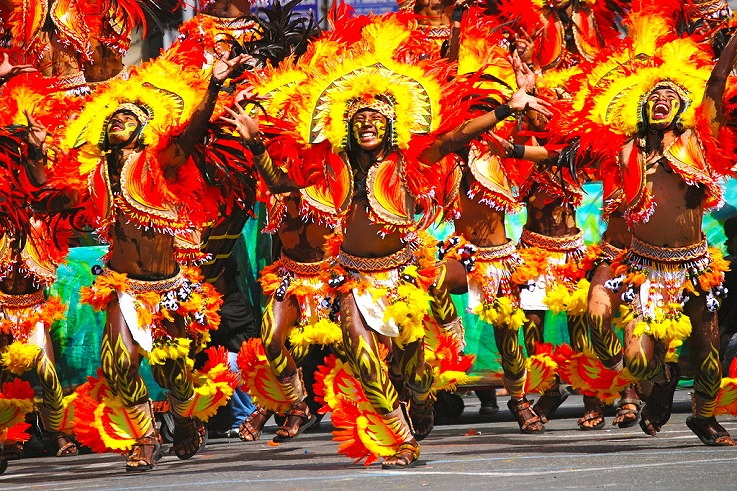In 1212, as legend has it, 10 Bornean datu (chiefs), fleeing the collapse of the once-mighty Srivijayan empire, sailed northwards with their followers and landed on the island of Panay. At that time, Panay was widely populated by Negritos. The Bornean Malays, although superior fighters and better armed than the Negritos, chose not to take the island by force but rather to buy it from the native inhabitants. They struck a deal with the local chieftain. A contract was made between Datu (chieftain) Puti of the Bornean and the Negritos’ chief Marikudo. There the Borneans bought the coastal lands from the native Negrito inhabitants with gold, pearls and other ornaments.

This legendary barter between Malays and native inhabitants is commemorated yearly in what is the most popular, colorful and exuberant festival in the whole country featuring a Mardi Gras like revelry worth a trip to Kalibo, Panay. On the third weekend of January, the small coastal town of Kalibo, plays host to thousands of Filipinos and foreign visitors who join the three-day revelry and fiesta known as Ati-Atihan.
As a concession to the Negritos, who were probably fleeced in the deal, the new Malay settlers in subsequent fiestas blackened their skin with coal to look more like the Negritos, or Ati, as they name themselves. In Panay, the tradition of which blackening of the skin to look like the Ati during fiesta is still very much alive today. Ati-Atihan means “making like Ati,” and refers to the dark Negrito aborigines, the original inhabitants of Panay.

The peace pact was later reinforced by a harvest feast prepared by the new arrivals for their Ati neighbors. Ever eager to please, the Bornean hosts made a merry welcome with gongs and cymbals, smeared soot on their faces and started dancing in the streets. The Christ-child figure of Santo Nino was only introduced in later years.
The local people plan the festival way in advance. Their costumes are wildly original and no one in town dares traipse around without a painted face, a camera, and a beer bottle or jug of coco wine in hand. Hotel prices rise considerably during this fiesta period, and rooms can be very difficult to find.
Today, as column upon column of sooted Ati-garbed locals beat on drums and cymbals and march in syncopated rhythm, wild dancing breaks out everywhere. The unceasing and deafening Ati-Atihan beat overloads the senses, inducing everyone to end up joining in the madcap fun.
Kalibo runs joyfully amok for three days and nights in celebration of the Atis selling a portion of Panay in the early thirteenth century to 10 families fleeing from Borneo. The descendants of these Bornean families have been grateful ever since, holding the Ati-Atihan festival to glorify peace and camaraderie among peoples. They march and brandish their spears, chanting, “Hala bira!” (Come on and join!). Participants and thousands of spectators dance and sing around the clock until the final night, when a procession of the participants closes the festival.
The Ati-Atihan celebration is so successful that it has been copied elsewhere in the Philippines , albeit with various twists to reflect local historical associations. In Iloilo City, a similar festival called Dinagyang takes place on the fourth weekend in January. Similar celebrations are also held at Cebu City called Sinulog. The Ati-Atihan dancing contingent is a much-awaited Independence Day photo opportunity in Manhattan, New York.
Sources:
Philippines Handbook
Insight Guide, Philippines by Discovery Channel
Traveler’s Philippines Companion by Kirsten Ellis
Until next time. The Philippines story continues. . .
Reblogged this on Rosalinda R Morgan and commented:
Is Kalibo’s Ati-Atihan Festival better than New Orleans’ Mardi Gras?
LikeLiked by 1 person
I like that the tradition has been followed.
(Thought you might like this piece of Long Island history)
https://www.warhistoryonline.com/instant-articles/satsunken-treasur.html?utm_source=getresponse&utm_medium=email&utm_campaign=warhistoryonline&utm_content=%5BWar+History+Online%5D+Daily+Dispatches
LikeLiked by 1 person
The costumes are wild but it looks like everyone is having a wonderful time. Thanks for link about the sunken treasure. I’ll check it out.
LikeLiked by 1 person
Thanks for the link. That was awesome. I wonder if Newsday or my old town’s newspaper carried that story. I’ve to check it out. Are you posting it on your blog?
LikeLiked by 1 person
No I am not.
LikeLiked by 1 person
I checked Newsday. Same article was published in Nov. 2018. There is a short video of the man showing his “finds”. I’m curious what he comes up with in the spring. Too cold to scuba dive now. Here’s the link: https://www.newsday.com/long-island/suffolk/thunderbolt-wreck-long-island-sound-1.23853556
LikeLiked by 1 person
Thanks, Rose. If you post a story on it, remind me to reblog!!!
LikeLiked by 1 person